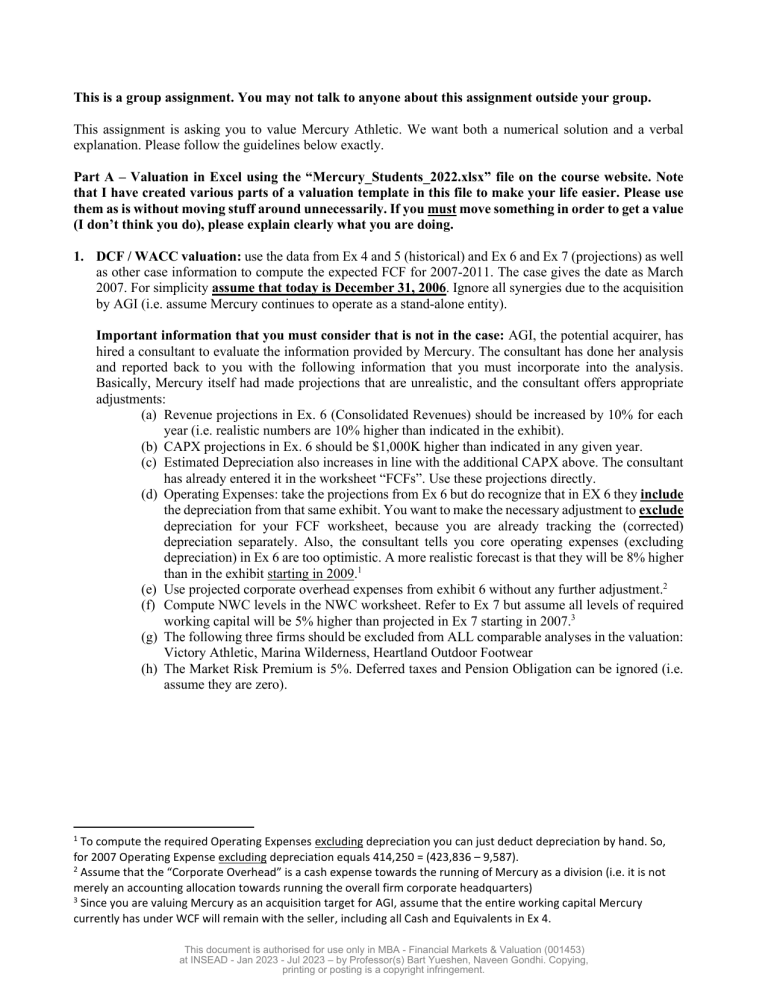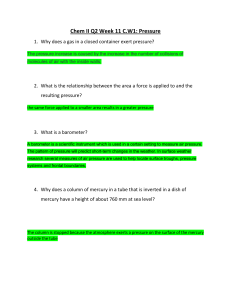
This is a group assignment. You may not talk to anyone about this assignment outside your group. This assignment is asking you to value Mercury Athletic. We want both a numerical solution and a verbal explanation. Please follow the guidelines below exactly. Part A – Valuation in Excel using the “Mercury_Students_2022.xlsx” file on the course website. Note that I have created various parts of a valuation template in this file to make your life easier. Please use them as is without moving stuff around unnecessarily. If you must move something in order to get a value (I don’t think you do), please explain clearly what you are doing. 1. DCF / WACC valuation: use the data from Ex 4 and 5 (historical) and Ex 6 and Ex 7 (projections) as well as other case information to compute the expected FCF for 2007-2011. The case gives the date as March 2007. For simplicity assume that today is December 31, 2006. Ignore all synergies due to the acquisition by AGI (i.e. assume Mercury continues to operate as a stand-alone entity). Important information that you must consider that is not in the case: AGI, the potential acquirer, has hired a consultant to evaluate the information provided by Mercury. The consultant has done her analysis and reported back to you with the following information that you must incorporate into the analysis. Basically, Mercury itself had made projections that are unrealistic, and the consultant offers appropriate adjustments: (a) Revenue projections in Ex. 6 (Consolidated Revenues) should be increased by 10% for each year (i.e. realistic numbers are 10% higher than indicated in the exhibit). (b) CAPX projections in Ex. 6 should be $1,000K higher than indicated in any given year. (c) Estimated Depreciation also increases in line with the additional CAPX above. The consultant has already entered it in the worksheet “FCFs”. Use these projections directly. (d) Operating Expenses: take the projections from Ex 6 but do recognize that in EX 6 they include the depreciation from that same exhibit. You want to make the necessary adjustment to exclude depreciation for your FCF worksheet, because you are already tracking the (corrected) depreciation separately. Also, the consultant tells you core operating expenses (excluding depreciation) in Ex 6 are too optimistic. A more realistic forecast is that they will be 8% higher than in the exhibit starting in 2009.1 (e) Use projected corporate overhead expenses from exhibit 6 without any further adjustment.2 (f) Compute NWC levels in the NWC worksheet. Refer to Ex 7 but assume all levels of required working capital will be 5% higher than projected in Ex 7 starting in 2007.3 (g) The following three firms should be excluded from ALL comparable analyses in the valuation: Victory Athletic, Marina Wilderness, Heartland Outdoor Footwear (h) The Market Risk Premium is 5%. Deferred taxes and Pension Obligation can be ignored (i.e. assume they are zero). 1 To compute the required Operating Expenses excluding depreciation you can just deduct depreciation by hand. So, for 2007 Operating Expense excluding depreciation equals 414,250 = (423,836 – 9,587). 2 Assume that the “Corporate Overhead” is a cash expense towards the running of Mercury as a division (i.e. it is not merely an accounting allocation towards running the overall firm corporate headquarters) 3 Since you are valuing Mercury as an acquisition target for AGI, assume that the entire working capital Mercury currently has under WCF will remain with the seller, including all Cash and Equivalents in Ex 4. This document is authorised for use only in MBA - Financial Markets & Valuation (001453) at INSEAD - Jan 2023 - Jul 2023 – by Professor(s) Bart Yueshen, Naveen Gondhi. Copying, printing or posting is a copyright infringement. Please proceed as follows: a. Use the template as given for your work, but you can add to it if you think you need to. b. Base your valuation on the “consolidated” Mercury – don’t worry about each division separately. c. At the bottom of the FCFs worksheet, make sure you “track” the following items: (i) sales growth rate; (ii) PP&E growth rate; (iii) book value of PP&E assets; (iv) EBIT Margin. d. Based on the data from Ex 3 that is already in the kU worksheet, compute the unlevered beta and then the unlevered cost of capital for Mercury. e. Compute the WACC in the WACC worksheet from the unlevered beta you already computed and from information from the case. Assume D/V f. Use the Base Case Value worksheet and complete the valuation of Mercury Athletic. After you forecast the cash flows for the “short run” until 2011, and based on the information in the case, make a reasonable forecast for the growth rate after 2011 to compute a Terminal Value. By “reasonable” I mean that these cash flows are meant to be “sustainable forever” so we can establish a Terminal Value based on an expected growing perpetuity. Tell me very briefly (!) in a cell near the growth rate that you assume where you get that growth estimate from. This completes your base case valuation for the enterprise value of Mercury. Again, we are still ignoring synergies. Part B - discussion: Write this part in Microsoft PowerPoint. There is a maximum slide count (5 slides total). Please do NOT exceed the maximum, but less is fine. Do not use fancy formatting. NOTE: you can write this even if you did not get the numbers in part A above perfectly. Assume that you are writing the PowerPoint to the CEO of your firm, AGI. a. Decide whether you want to prepare i. A pitch in favor of the acquisition, e.g., in person of Active Gear’s bankers (or) ii. A pitch that is rather skeptic about the acquisition. Feel free to include synergies, but be prepared to defend the additional assumptions you make b. Explain in words (without using a single number) what comparable firm and what multiple you would use to estimate the value of Mercury (You can choose only ONE multiple, and only ONE comparable firm from Exhibit 3), and why. Please also discuss the benefits and weaknesses of this valuation approach for assessing the price that AGI should pay to acquire Mercury. Use full sentences and structure your explanation. This document is authorised for use only in MBA - Financial Markets & Valuation (001453) at INSEAD - Jan 2023 - Jul 2023 – by Professor(s) Bart Yueshen, Naveen Gondhi. Copying, printing or posting is a copyright infringement.


